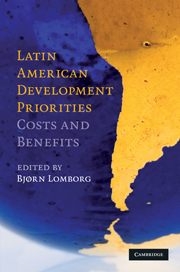Book contents
- Frontmatter
- Contents
- List of figures
- List of tables
- List of contributors
- Acknowledgments
- Abbreviations and acronyms
- Expert panel findings
- Introduction
- Democracy
- Education
- 2 Three proposals to improve education in the LAC region: estimates of the costs and benefits of each strategy
- 2.1 Education: an alternative view
- Employment and social security
- Environment
- Fiscal problems
- Health
- Infrastructure
- Poverty
- Public administration
- Violence and crime
- Conclusion
2 - Three proposals to improve education in the LAC region: estimates of the costs and benefits of each strategy
Published online by Cambridge University Press: 05 June 2012
- Frontmatter
- Contents
- List of figures
- List of tables
- List of contributors
- Acknowledgments
- Abbreviations and acronyms
- Expert panel findings
- Introduction
- Democracy
- Education
- 2 Three proposals to improve education in the LAC region: estimates of the costs and benefits of each strategy
- 2.1 Education: an alternative view
- Employment and social security
- Environment
- Fiscal problems
- Health
- Infrastructure
- Poverty
- Public administration
- Violence and crime
- Conclusion
Summary
Introduction
Many macroeconomists have claimed that increased levels of education lead to increased economic growth (Lucas 1988; Barro 1991; Mankiw, Romer, and Weil 1992), although others have questioned these findings (Bils and Klenow 2000; Pritchett 2001). Among microeconomists, many studies have provided evidence of the impact of education on individuals' incomes (see Glewwe 2002, for a review). Education is also seen as a means to improve health and reduce fertility (Strauss and Thomas 1995; Schultz 1997, 2002) and is seen as an intrinsic good in itself (Sen 1999: 292–7).
This support for education among economists is matched by even greater enthusiasm in, and financial support from, international development institutions (World Bank 2001; UNDP 2003). As discussed below, developing countries have massively expanded their education systems since the 1960s, perhaps in response to the enthusiasm of donors. One example of the focus policymakers have placed on education is that two of the eight Millennium Development Goals (MDGs) adopted at the UN Millennium Summit in September 2000 focus on education: first, all children should complete primary school by 2015, and second, gender equality should be attained at all levels of education by 2015.
- Type
- Chapter
- Information
- Latin American Development PrioritiesCosts and Benefits, pp. 45 - 91Publisher: Cambridge University PressPrint publication year: 2010
- 1
- Cited by



